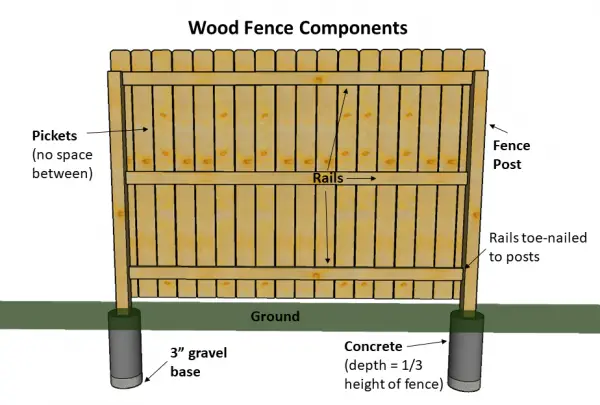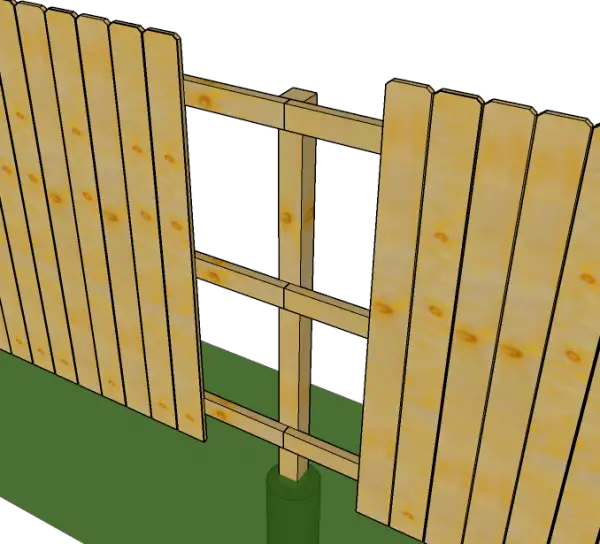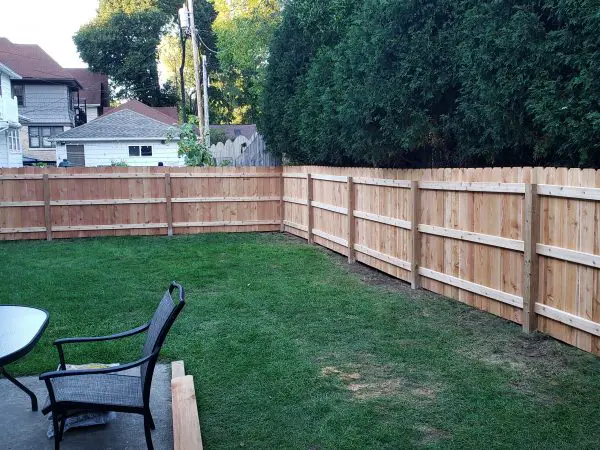This fence calculator will calculate the material required to build a wood fence, including quantities and sizes of posts, pickets, and rails.
It will also calculate the post hole size, amount of concrete, gravel and nails required.
To calculate the weight of the lumber, check out the lumber weight calculator.
Just a heads up, this page contains affiliate links. If you buy through them I earn a small commission. If you chose to buy through these links I truly thank you for your support! – Jake
FENCE CALCULATOR
This fence material calculator assumes the following:
-
- Fence sections (fencing between posts) are all equal in length
- Fence height and section length less than 8′
- Max fence length for this calculator is 200′
- Posts are 4×4’s and rails are 2×4’s
- Grass/topsoil to cover post concrete for more aesthetically pleasing look. For more robust post install method, check out the post hole calculator.
Wood Fence Anatomy
The image below shows some of the common materials used in a typical wood picket fence:

How to Use the Calculator
Fence Dimensions
First figure out how long and tall you want your fence to be. This calculator works for a straight run of fence or for a perimeter fence. If you want a rectangular fenced area, for example, enter in the total perimeter of the fence under “fence length.”
The height of the fence is measure from the ground to the top of the pickets. Standard wood fences are usually anywhere from 4.5′ to 8′ tall.
Next, decide what width pickets you want to use. Wider pickets can give the fence a more modern look, while narrower pickets will make the fence look more detailed.
Picket Spacing
Decide if you want any gap between pickets. This is purely for aesthetics. Less gap equals more privacy but also means less light that can filter through. If you decide to have gaps make sure they are narrow enough to keep wanted things in (i.e. dogs and children) and unwanted things out.
Then, you will want to decide what size gap to have between the ground and the bottom of the fence pickets. It is important to have a gap here to prevent premature rot of the pickets. Common gap under the fence is 1″-2″.
Fence Structure
Next, decide how to attach your fence rails to the fence posts. They can either be face nailed to the posts or toe nailed. A diagram of rails that are toe-nailed can be seen above. Here is what a face nailed wood fence looks like:
Wood Fence Installation Tips and Tricks

Setting Posts
-
- Use pressure treated lumber for posts since they will be in contact with the ground
- An 8″ auger will cut about a 9″ diameter hole which is plenty wide for a 4×4 post and concrete
- A 3″ base of gravel underneath each post allows for water to drain away from the base of the post, preventing wood rot
- Quikrete concrete for fence posts can be mixed in the hole, making for easier post setting and cleanup
- 1, 50# bag of concrete per post is plenty adequate for a fence under 5′ and 2 bags is enough for a fence between 5′ and 8′
- The amount of post buried in the ground should be equal to 1/3 to 1/2 of the fence height for adequate wind resistance and resistance to freeze/thaw cycles
- Cut posts flush with top rail, about 6″ below top of fence
Installing Rails and Pickets
-
- Pressure treated, cedar, and redwood are common wood choices for rails and pickets
- When the fence is built on a slope, the rails can either be made parallel to the ground or level and stepped up/down a certain amount from section to section
- Space rails so that top rail is about 6″ below top of fence (flush with top of post), bottom rail is about 6″ above bottom of pickets, and middle rail (if applicable) is halfway in between
- If there is no gap left between pickets when the fence is installed, an 1/8″-1/4″ gap will eventually appear due to wood shrinkage. This assumes the wood bought for the fence is not kiln dried first
- Use a framing nail gun to make things go a lot quicker. I’ve used this model to build a couple fences and it has performed very well. It’s also a steal for less than a hundred bucks.
- Use galvanized ring shank nails in conjunction with a nail gun for a quick and efficient way to fasten the pickets to the rails. Here’s why you should be using galvanized fasteners.
FAQ
What are pickets and rails?
Pickets are vertical pieces of wood that run the length of a fence and make up the bulk of the fence material. Rails are the horizontal pieces of lumber, often 2x4s, that the pickets are fastened to.
Is face nailing or toe-nailing the rails to the posts better?
Either method is suitable. With toe-nailing, it is a little trickier to attach the rails to the posts but you end up needing slightly shorter rails which saves a little bit of money.
There will also be a 1.5″ gap between the pickets and the posts if the rails are face nailed to the posts. If you don’t like how this looks then they should be toe-nailed.
Do I need to finish my fence with stain or paint?
If you are using cedar pickets and pressure treated rails and posts, the fence can be left as is. The cedar pickets will eventually fade to a gray color but will still stand up to the weather for quite some time.
If you choose to stain or seal cedar, some recommend waiting a couple months to allow the oils in the wood to stabilize and be better able to accept the finish.
If you are using green pressure treated pickets, you will most likely want to paint them unless you like the greenish hue of pressure treated lumber. Just remember to allow the lumber to dry for a couple months first.
Do I need to set my posts in concrete?
It would be wise to set posts in concrete to get the maximum life out of them. Posts buried directly in the dirt may work for some time but the moisture and freeze-thaw cycles (if you live in an area with cold winters) will quickly rot and heave them up from the ground. If you ever see a leaning fence it is usually because the posts aren’t set deep enough or aren’t set in concrete.
There is an expanding foam product with good reviews that can be used as an alternative to concrete for setting posts. I haven’t used this before, however, so I can’t speak to it’s long term durability.
A wood picket fence is a great way to add privacy to a home or to keep the dogs in the yard. By following a few general rules this can easily be a weekend DIY project. For a step by step tutorial on how to build a wood fence, check out Home Depot’s Fence Building How-To.

